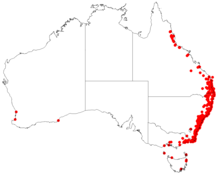Kennedia rubicunda
| Dusky coral pea | |
|---|---|

| |
| Kennedia rubicunda | |
| Scientific classification | |
| Kingdom: | Plantae |
| Clade: | Tracheophytes |
| Clade: | Angiosperms |
| Clade: | Eudicots |
| Clade: | Rosids |
| Order: | Fabales |
| Family: | Fabaceae |
| Subfamily: | Faboideae |
| Genus: | Kennedia |
| Species: | K. rubicunda
|
| Binomial name | |
| Kennedia rubicunda | |

| |
| Australian occurrence data from Australasian Virtual Herbarium | |
| Synonyms[1] | |
Kennedia rubicunda, commonly known as the dusky coral pea,[2] is a species of flowering plant in the family Fabaceae and is endemic to eastern continental Australia. It is a twining or prostrate herb with trifoliate leaves and dark red or purple flowers.
Description
[edit]Kennedia rubicunda is a twining or prostrate herb with stems up to 4 metres (13 ft) long and covered with rusty-brown hairs. The leaves are trifoliate on a petiole 10–50 mm (0.39–1.97 in) long, the leaflets egg-shaped to lance-shaped, 30–120 mm (1.2–4.7 in) long and 20–80 mm (0.79–3.15 in) wide with lance-shaped stipules 2–4 mm (0.079–0.157 in) long at the base of the petiole. Dark red pea flowers are arranged in racemes of up to twelve on a peduncle 20–70 mm (0.79–2.76 in) long, each flower on a pedicel 10–20 mm (0.39–0.79 in) long. The sepals are 10–15 mm (0.39–0.59 in) long and densely covered with rusty-brown hairs and the petals are 30–40 mm (1.2–1.6 in) long. Flowering mostly occurs from September to December and the fruit is a rusty-hairy, flattened pod 50–100 mm (2.0–3.9 in) long containing ten to fifteen seeds.[2][3][4][5]
Taxonomy
[edit]Dusky coral pea was first formally described in 1793 by Dutch botanist George Voorhelm Schneevoogt, who gave it the name Glycine rubicunda in his book Icones Plantarum rariorum.[6][7] In 1804 it was published under its current name by French botanist Étienne Pierre Ventenat in his book, Jardin de la Malmaison.[8][9] The specific epithet (rubicunda) refers to the species' red flowers.[10]
Distribution and habitat
[edit]Kennedia rubicunda is widespread in a variety of habitats, including in forests and rainforest margins, on the coast and nearby tablelands of Queensland, New South Wales and far eastern Victoria.[2][3][11] It is an introduced species in India, Tasmania and the North Island of New Zealand[12] (where it is considered a weed).[13]
Ecology
[edit]Flowers of K. rubicunda are pollinated by birds.[14] Seed dispersal by ants (myrmecochory) has been reported,[15] in which ants are attracted to fatty acid-rich elaiosomes attached to the outside of the seeds.[16] The plant is killed by bushfire but regenerates from seed dormant in the soil and is often abundant after fire.[3][17] K. rubicunda forms a symbiosis with soil nitrogen fixing bacteria (rhizobia) resulting in the formation of nodules on the roots that fix atmospheric nitrogen which is used for plant growth.[18]
Use in horticulture
[edit]This plant is noted for its vigour and can be used to cover embankments or structures.[19] The species is adapted to a range of well-drained soils and adapts to positions with sun or partial shade.[20] It is resistant to drought and has some frost tolerance.[20] The species can be propagated by scarified seed or cuttings of semi-mature growth.[20]
References
[edit]- ^ a b "Kennedia rubicunda". Australian Plant Census. Retrieved 29 October 2021.
- ^ a b c "Kennedia rubicunda". PlantNET - New South Wales Flora Online. Royal Botanic Gardens & Domain Trust, Sydney Australia. Retrieved 2008-09-25.
- ^ a b c Jeanes, Jeff A. "Kennedia rubicunda". Royal Botanic Gardens Victoria. Retrieved 29 October 2021.
- ^ Wood, Betty. "Kennedia rubicunda". Lucid Keys. Retrieved 29 October 2021.
- ^ Morcombe, Michael (1991). Australia's Wildflowers (Réimpr. ed.). Sydney: The Book Company and Ure Smith Press. p. 26. ISBN 978-0725408732.
- ^ "Glycine rubicunda". APNI. Retrieved 29 October 2021.
- ^ Schneevoogt, George V. (1793). Icones Plantarum Rariorum. Te Harlem: C. Plaat. p. 28. Retrieved 29 October 2021.
- ^ "Kennedia rubicunda". APNI. Retrieved 29 October 2021.
- ^ Ventenat, Étienne P. (1804). Jardin de la Malmaison. Vol. 2. Paris. p. 104. Retrieved 29 October 2021.
- ^ "Kennedia rubicunda". Australian Native Plants Society (Australia). Retrieved 21 November 2024.
- ^ "Kennedia rubicunda". Atlas of Living Australia. Retrieved 29 October 2021.
- ^ Govaerts, R. et al. 2018. "Plants of the World online: Kennedia rubicunda". Board of Trustees of the Royal Botanic Gardens, Kew. Retrieved 2 July 2018.
- ^ NZ Flora Kennedia rubicunda (Schneev.) Vent. Retrieved 2 July 2018
- ^ Wilson, Karen L; Morrison, David A, eds. (2000). Monocots: Systematics and Evolution. doi:10.1071/9780643090149. ISBN 9780643090149.
- ^ Rice, Barbara; Westoby, Mark (1981). "Myrmecochory in sclerophyll vegetation of the West Head, New South Wales". Australian Journal of Ecology. 6 (3): 291–298. Bibcode:1981AusEc...6..291R. doi:10.1111/j.1442-9993.1981.tb01579.x. ISSN 1442-9993.
- ^ O'Hanlon, James C.; Hill, Sarah J.; Andrew, Nigel R. (2019). "Using devitalised seeds in myrmecological research". Austral Entomology. 58 (4): 805–809. doi:10.1111/aen.12399. ISSN 2052-1758. S2CID 182936843.
- ^ Benson, Doug; McDougall, Lyn (1996). "Ecology of Sydney Plant Species Part 4: Dicotyledon family Fabaceae". Cunninghamia. 4 (4): 623. ISSN 0727-9620. Retrieved 9 December 2024.
- ^ Staehelin, Christian; Forsberg, Lennart S.; D'Haeze, Wim; Gao, Mu-Yun; Carlson, Russell W.; Xie, Zhi-Ping; Pellock, Brett J.; Jones, Kathryn M.; Walker, Graham C.; Streit, Wolfgang R.; Broughton, William J. (September 2006). "Exo-Oligosaccharides of Rhizobium sp. Strain NGR234 Are Required for Symbiosis with Various Legumes". Journal of Bacteriology. 188 (17): 6168–6178. doi:10.1128/JB.00365-06. ISSN 0021-9193. PMC 1595362. PMID 16923883.
- ^ Greig, D. (1987). The Australian Gardener's Wildflower Catalogue. Australia: Angus & Robertson. ISBN 978-0207154607.
- ^ a b c Bodkin, Frances (1991). Encyclopaedia Botanica. Australia: Cornstalk Publishing. ISBN 978-0207150647.
